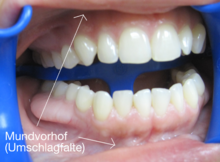Schlotterkamm (dentistry)
Under a flabby is understood in the dentistry an alveolar (ridge) in the edentulous jaw , the bone substance is completely or partly in the granulation tissue that has been converted.
Other names
In the literature, the Schlotterkamm is called differently, so as a spongy alveolar ridge (Unger), movable ridge (Grohs), horizontally movable ridge (Trebitsch) or flexible alveolar ridge (Wild).
root cause
The Schlotterkamm is a fibromatosis of the alveolar ridge. An incorrect mechanical load on the jawbone leads to a mucosal hyperplasia due to inadequate dentures , which is associated with pressure-related bone atrophy of the alveolar ridge. The incorrect loading usually occurs in the anterior region of the upper jaw when a partial or full denture is worn there and the posterior teeth (molars, i.e. the premolars and molars ) are missing in the lower jaw . The impact of the lower front teeth on the upper denture creates leverage forces with every bite, which means that the denture is exposed to constant tilting movements. The same consequences can arise from poor occlusion in patients with full dentures in the upper and lower jaw. The formation of a ridge can also be observed if the wearer of a full denture in the upper jaw does not wear the partial denture in the lower jaw to replace the premolars and molars.
Symptoms
In the case of the Schlotterkamm, the alveolar process in the oral cavity appears to be well preserved. Under the mucous membrane, however, the bony alveolar process is replaced by connective tissue, so that the alveolar ridge is mobile and "shakes". This means that a full denture does not rest firmly on the jaw. The diagnosis is made by palpating the alveolar ridge, whereby the mobility of the jaw part can be determined.
therapy
A pronounced ridge should be corrected surgically before a new denture is incorporated. Surgical correction of the ridge of the ridge inevitably leads to a loss of height of the alveolar ridge. The fibromatous tissue is usually removed using a wedge-shaped excision. Care is taken to ensure that the keratinized mucous membrane is preserved so that the alveolar ridge is covered with the gingiva propria and not with the vestibular mucosa as far as possible . The fibrous tissue is excised after submucosal folding down to the level of the aveolar ridge. The excision can be combined with a secondary vestibuloplasty that is performed in a separate procedure . This becomes necessary if the jaw has become too flat due to the removal of the ridges and has to be raised again indirectly by deepening the oral vestibule (area of the so-called envelope fold). In the case of a planned implant restoration, the ridge of the ridge is removed in the course of the implant exposure. Operations by Wassmund, Heiss, and Kazanjian were developed as a procedure. Procedures with a flap pedunculated towards the lip (labially pedicled) according to Clark or with a flap pedunculated at the gumline (marginal pedunculated) according to Edlan and Mejchar are preferred.
If an operative correction of the ridge ridge is not possible, the ridge ridge is coated with a thin layer of plaster of paris in order to stiffen the mobility of the alveolar ridge during the impression for a new prosthesis. This dental plaster according to EN ISO 6873 corresponds to type I impression and impression plaster , a β-hemihydrate with a 0.15% setting expansion and 4 N / mm² compressive strength.
Individual evidence
- ^ E. Hockenjos, Roland Bay, Alfred R. Egli et al .: Dentistry: Contributions to dentistry on the occasion of the 25th anniversary of the Dental Institute of the University of Basel 1924–1949 . Springer-Verlag, November 21, 2013, ISBN 978-3-0348-5898-4 , p. 43.
- ↑ Norbert Schwenzer: Dental surgery: 35 tables . Georg Thieme Verlag, 2000, ISBN 978-3-13-116963-1 , p. 108–.
- ↑ Uwe Eckelt: Dental, Oral and Maxillofacial Medicine: Dental Surgery: 35 tables / ed. by Norbert Schwenzer; Michael Ehrenfeld. With contrib. By Uwe Eckelt ... . Georg Thieme Verlag, 2009, ISBN 978-3-13-116964-8 , p. 200.
- ↑ I. Mieler, p Kubetschek: [The Edlan / Mejchar surgical method and its modifications]. In: Dental, oral and maxillofacial medicine with Zentralblatt. Volume 74, Number 3, 1986, pp. 249-258, ISSN 0303-6464 . PMID 2941939 .
- ^ Siegfried Ernst, Hans H. Caesar: The non-metals . Verlag Neuer Merkur GmbH, 2007, ISBN 978-3-937346-31-1 , p. 58 ( google.com ).

